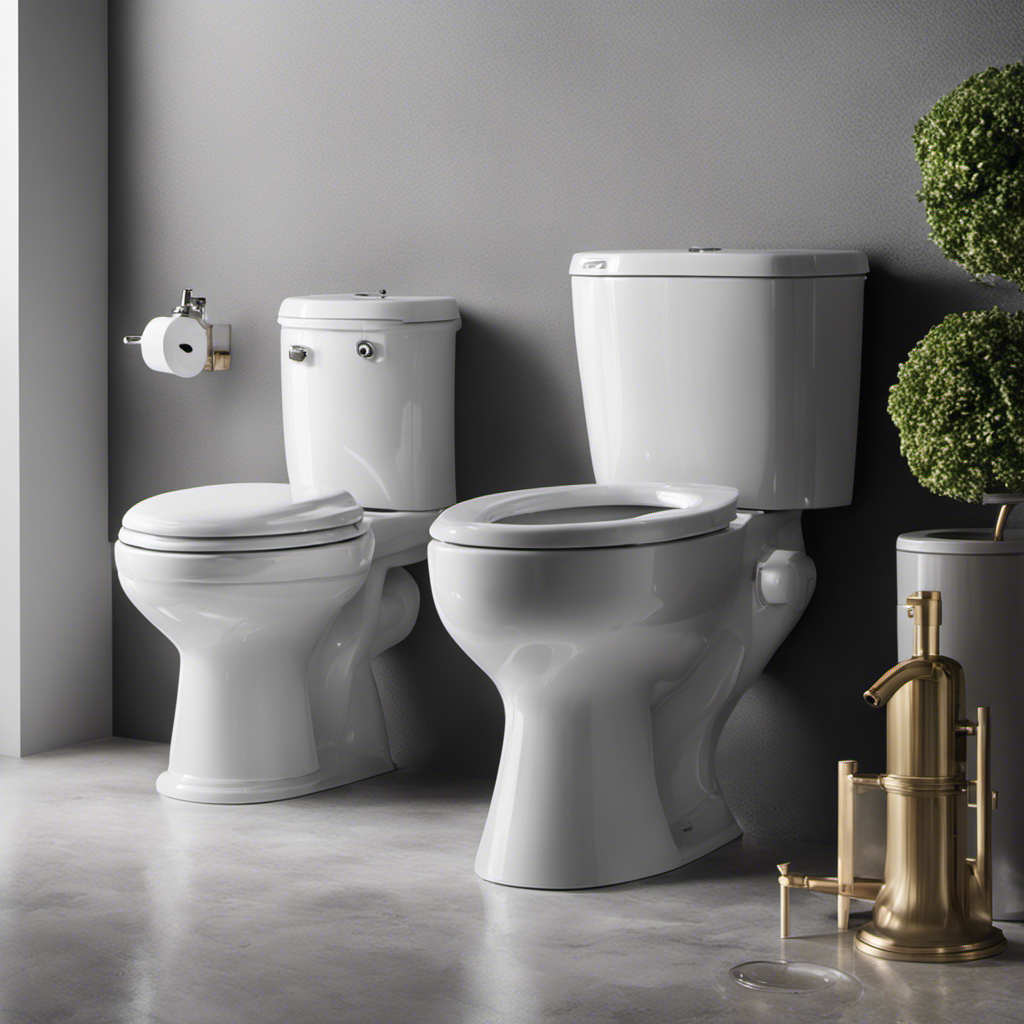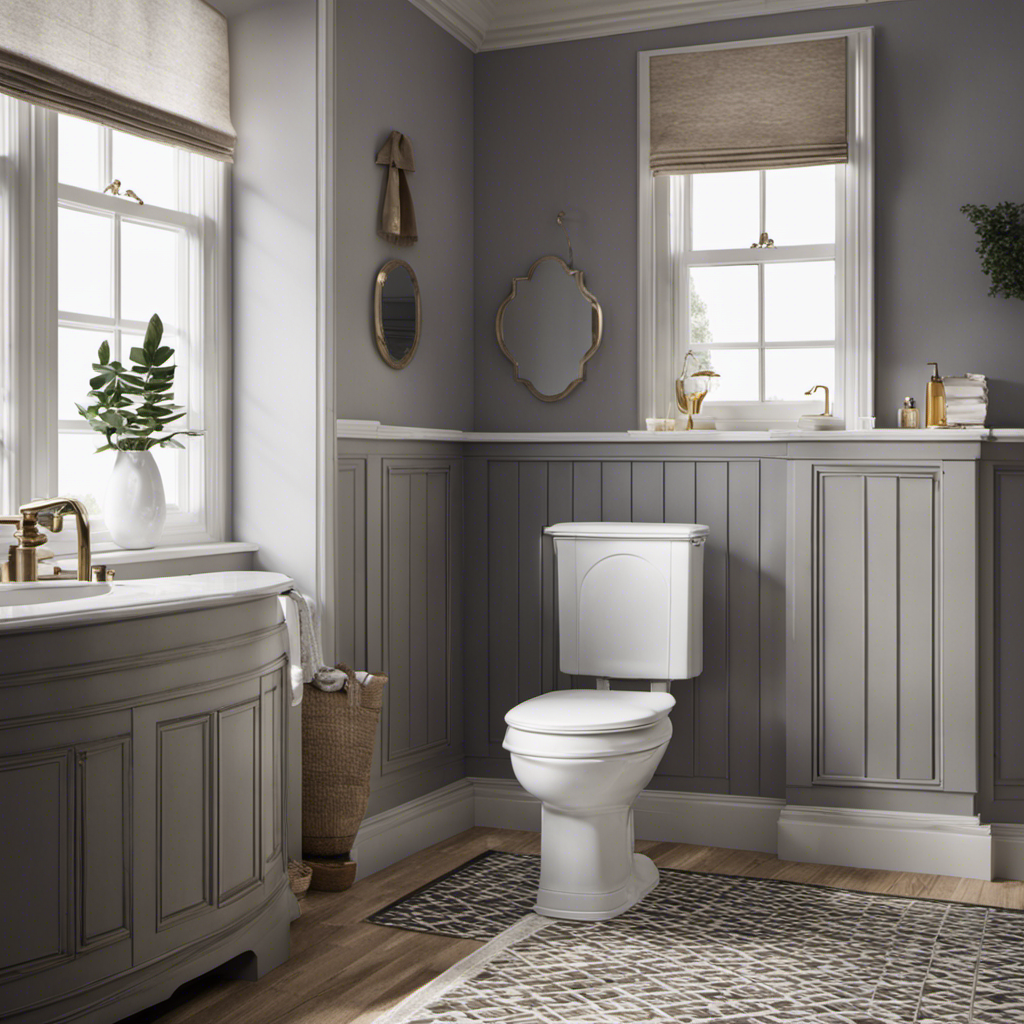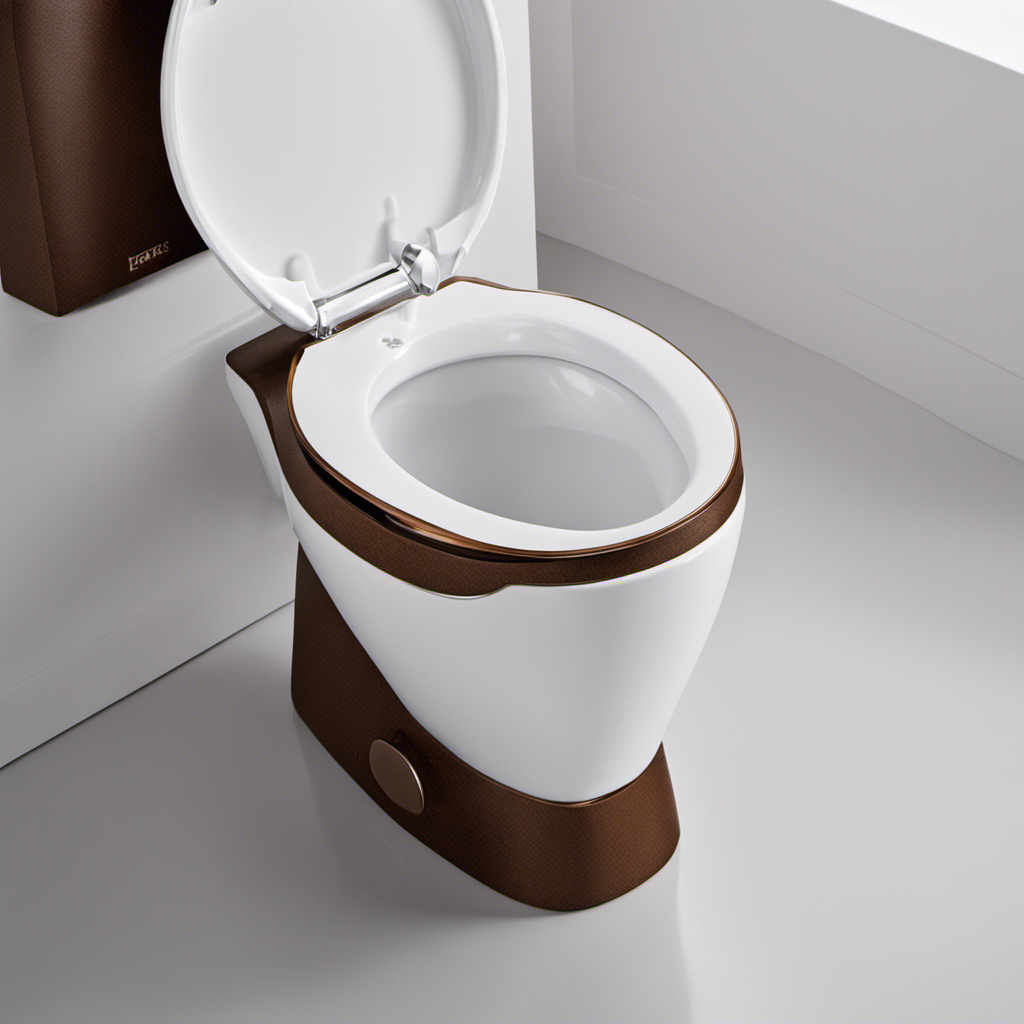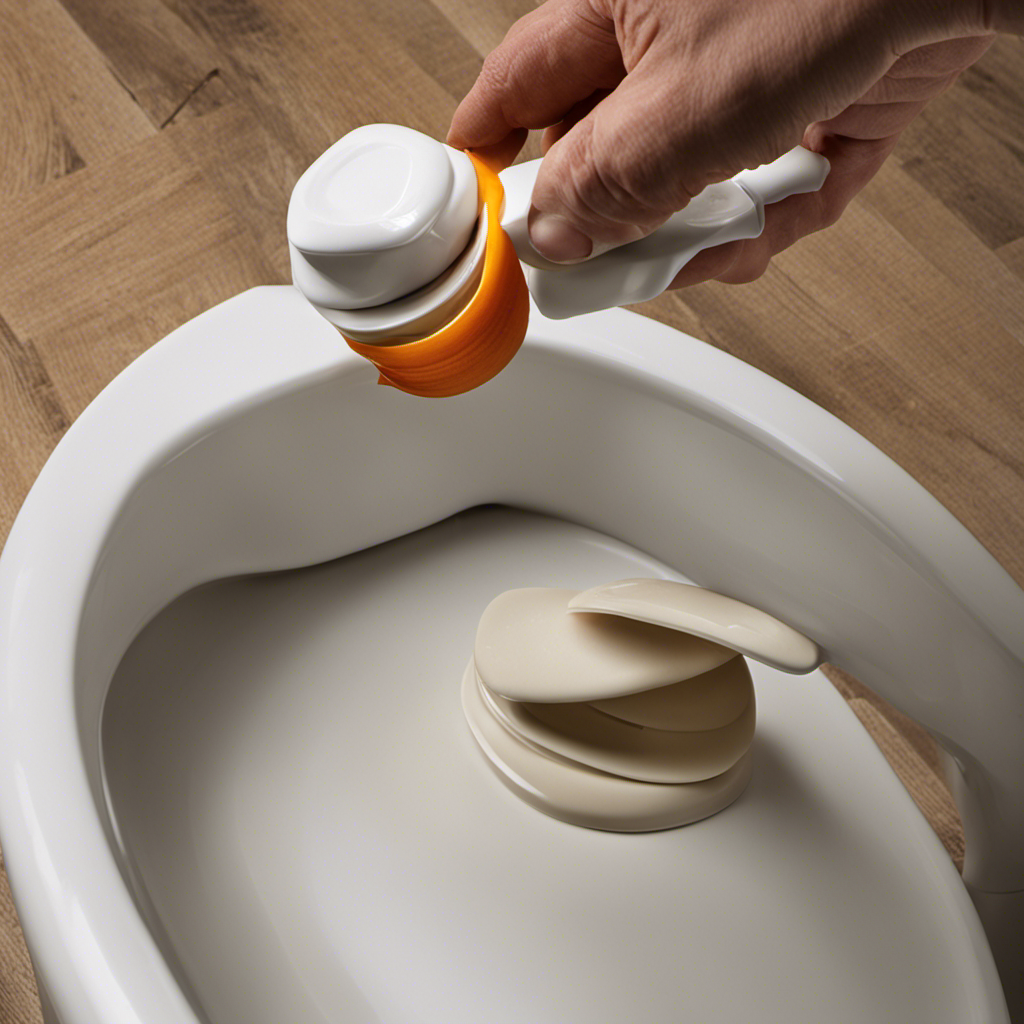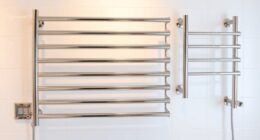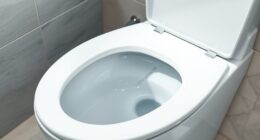I know what you’re thinking: ‘Toilet gurgling when flushed? What could possibly be causing that?’ Well, let me tell you, there are several common causes for this irritating phenomenon. Understanding how your plumbing system works is key to identifying the issue.
In this article, I will guide you through determining if the vent stack is blocked and provide step-by-step instructions on how to clear it. We will also discuss signs of a clogged main drain line and DIY methods to unclog it. However, there are instances when it’s best to call a professional plumber.
Stick around, because we’re about to dive deep into the world of toilet gurgling.
Key Takeaways
- Toilet gurgling when flushed is often caused by a blocked vent stack.
- Signs of a blocked vent stack include slow draining, foul odors, and gurgling sounds from other drains or toilets.
- Clearing a blocked vent stack can be done using a plunger, drain snake, or chemical drain cleaner.
- Regular maintenance and inspections of the plumbing system, including the vent stack, can prevent gurgling toilets and slow drains.
Common Causes of Toilet Gurgling
One common cause of toilet gurgling is a clogged vent pipe. The vent pipe is responsible for allowing air to enter the plumbing system, which helps in maintaining proper water flow and preventing pressure buildup.
When the vent pipe becomes clogged with debris or obstructed by a bird’s nest or other objects, it can lead to gurgling noises when you flush the toilet.
To fix this issue, you can try using a plumber’s snake or a high-pressure water jet to clear the blockage in the vent pipe. Another solution is to hire a professional plumber who can inspect and clean the vent pipe thoroughly.
Understanding the Plumbing System
Understanding the plumbing system means comprehending why the toilet makes that noise when it’s flushed. The plumbing system is a complex network of pipes and fixtures that work together to provide water supply and waste removal in a building.
Regular plumbing system maintenance is crucial to avoid common toilet problems like gurgling. Gurgling noises may indicate a blockage in the vent stack, which is responsible for releasing sewer gases and maintaining proper air pressure in the system.
To determine if the vent stack is blocked, you can perform a simple test. Close all the windows and doors in your home and flush the toilet. If you hear gurgling sounds coming from other drains or toilets, it is likely that the vent stack is blocked.
Proper maintenance and regular inspections can help prevent these issues and keep your plumbing system running smoothly.
How to Determine if the Vent Stack Is Blocked
When it comes to plumbing issues, one common problem is a blocked vent stack. Signs of a blockage can include slow drains, gurgling noises, and unpleasant odors.
In this discussion, I will delve into the signs of a blocked vent stack and provide troubleshooting tips to resolve the issue efficiently.
Signs of Blockage
If your toilet is gurgling when flushed, it’s likely a sign of a blockage. Blockages in the plumbing system can cause disruptions in the flow of water and lead to various issues. Here are some signs that indicate a blockage:
-
Slow draining: If water takes longer than usual to drain from the toilet bowl or sink, it could be due to a blockage in the pipes.
-
Overflowing: When a blockage prevents water from flowing freely, it can cause the toilet to overflow, resulting in a messy and unpleasant situation.
-
Foul odors: A blocked sewer line can cause unpleasant smells to emanate from drains and toilets.
-
Multiple clogs: If you are experiencing blockages in multiple fixtures, it could indicate a blockage in the main sewer line.
-
Strange noises: Gurgling sounds or bubbling noises coming from the toilet can be a clear indication of a blockage.
To clear blockages and prevent future occurrences, regular maintenance and proper usage of the plumbing system are essential.
Troubleshooting Vent Stack
To troubleshoot issues with your plumbing system’s vent stack, start by checking for any visible blockages or obstructions. The vent stack plays a crucial role in maintaining proper ventilation in your plumbing system. It allows air to enter the drain pipes, preventing negative pressure and ensuring proper drainage. Neglecting the vent stack can lead to a variety of problems, including gurgling toilets, slow drains, and even sewer gas backups. Regular vent stack cleaning is essential to maintain the integrity of your plumbing system. By removing any debris or buildup, you can ensure that air flows freely through the pipes, preventing any potential issues. Proper ventilation is vital for the overall functionality and efficiency of your plumbing system, so don’t overlook the importance of vent stack maintenance.
| Benefits of Vent Stack Cleaning |
|---|
| Prevents blockages |
| Maintains proper ventilation |
| Improves plumbing system’s efficiency |
Steps to Clear a Blocked Vent Stack
I’ve encountered many cases where a blocked vent stack has caused issues with the plumbing system. Understanding the causes of blockage is crucial in order to effectively clear the vent and prevent future problems.
In this discussion, I will delve into the common causes of blockage. I’ll provide step-by-step instructions on clearing the vent and share some preventive maintenance tips to keep the plumbing system running smoothly.
Causes of Blockage
One possible cause of the blockage could be a buildup of debris in the pipes. This can occur when items such as toilet paper, hair, or soap scum accumulate and restrict the flow of water.
When faced with a blocked toilet, it is important to be aware of the common symptoms which include slow draining, gurgling noises, and water backup.
To address this issue, there are several solutions for blockage that can be considered:
- Using a plunger to create pressure and force the blockage through.
- Utilizing a drain snake or auger to physically remove the debris.
- Applying a chemical drain cleaner to dissolve the blockage.
- Seeking professional help from a plumber for more complex blockages.
- Implementing preventive measures such as regular pipe maintenance and avoiding flushing foreign objects.
Taking these steps can help resolve the blockage and restore proper functioning to your toilet.
Clearing the Vent
Using a drain snake or auger can physically remove debris causing a blockage in the vent. Clearing clogs in the vent stack is an essential part of maintenance to ensure proper functioning of your plumbing system. Neglecting this task can lead to unpleasant issues like gurgling toilets or slow draining sinks.
To effectively clear the vent, follow these steps:
-
Identify the vent stack location: Check your roof for a vertical pipe sticking out. This is the vent stack.
-
Remove the vent cap: Use a screwdriver to take off the cap from the vent stack.
-
Insert the drain snake: Carefully push the drain snake down the vent stack until you encounter resistance.
-
Rotate and remove debris: Rotate the drain snake to dislodge any clogs and then pull it out, taking the debris with it.
Regular vent stack maintenance is crucial for maintaining a healthy plumbing system. By following these steps, you can clear clogs and prevent future blockages.
Preventive Maintenance Tips
By regularly maintaining your plumbing system, you can prevent future blockages and ensure its proper functioning. Here are some important tips for toilet bowl maintenance to help prevent toilet clogs:
- Use a plunger to clear minor clogs.
- Avoid flushing non-flushable items, such as wipes or sanitary products.
- Regularly clean the toilet bowl and remove any mineral deposits or buildup.
- Check the water level in the tank to ensure it is not too high or too low.
- Inspect the flushing mechanism and replace any worn-out parts promptly.
Following these preventive maintenance tips will not only save you from the hassle of dealing with clogs but also help extend the lifespan of your plumbing system.
Now, let’s move on to discussing the signs of a clogged main drain line.
Signs of a Clogged Main Drain Line
If your toilet is gurgling when you flush it, it’s a sign that your main drain line might be clogged. Diagnosing main drain issues can be tricky, but there are a few telltale signs to look out for. Aside from the gurgling toilet, other signs include slow drainage in multiple fixtures, water backing up into sinks or showers, and a foul odor coming from your drains. Fixing a clogged main drain line is not a DIY task and requires professional assistance. A plumber will use specialized equipment, such as a drain snake or hydro jetting, to clear the clog and restore proper flow. It’s important to address a clogged main drain line promptly to prevent further damage to your plumbing system.
| Signs of a Clogged Main Drain Line |
|---|
| Gurgling toilet when flushed |
| Slow drainage in multiple fixtures |
| Water backing up into sinks/showers |
| Foul odor from drains |
DIY Methods to Unclog Main Drain Line
One option for unclogging a main drain line without professional assistance is to use a drain snake. It is a simple tool that can effectively clear blockages in the pipes.
Here are some DIY unclogging techniques for clearing a main drain blockage:
-
Boiling water: Pouring boiling water down the drain can help dissolve grease and other substances that may be causing the blockage.
-
Baking soda and vinegar: Mixing these two ingredients creates a chemical reaction that can break down clogs.
-
Plunger: Using a plunger can create enough pressure to dislodge the blockage and clear the drain.
-
Wire hanger: Straightening out a wire hanger and using it to manually remove debris from the drain can be effective.
-
Enzyme cleaners: These cleaners contain enzymes that can break down organic matter and clear the blockage.
When to Call a Professional Plumber
When dealing with persistent blockages or multiple drains backing up simultaneously, it’s time to call a professional plumber for assistance. While there are certain plumbing issues that can be resolved through DIY methods, there are times when it’s best to leave it to the experts. Plumbing problems can be complex and require specialized knowledge and tools to fix effectively. One common sign that indicates the need for a professional plumber is a faulty toilet flush valve. This can cause the toilet to gurgle when flushed and may indicate a larger issue with the plumbing system. A professional plumber will be able to diagnose the problem accurately and provide the necessary repairs to ensure your plumbing system is working properly.
| Signs of a Faulty Toilet Flush Valve | ||
|---|---|---|
| Gurgling sound when flushing | Slow or weak flush | Continuous water running in the toilet bowl |
| Water leaking around the toilet base | Water rising in the bowl after flushing | Difficulty in flushing solid waste |
| Toilet not refilling properly after flushing | Frequent clogs or backups | Visible wear and tear on the flush valve components |
Conclusion
In conclusion, toilet gurgling can be a sign of various underlying plumbing issues. By understanding the plumbing system and identifying the possible causes, such as a blocked vent stack or clogged main drain line, you can take steps to resolve the problem.
DIY methods may work in some cases, but it’s important to know when to call a professional plumber for assistance. Just like a skilled surgeon, a plumber can diagnose and fix the issue with precision, ensuring that your toilet functions smoothly like a well-oiled machine.
